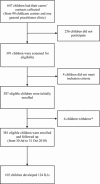Estimates and determinants of economic impacts from influenza-like illnesses caused by respiratory viruses in Australian children attending childcare: a cohort study
- PMID: 23829670
- PMCID: PMC4634260
- DOI: 10.1111/irv.12138
Estimates and determinants of economic impacts from influenza-like illnesses caused by respiratory viruses in Australian children attending childcare: a cohort study
Abstract
Background: Influenza and other respiratory infections cause excess winter morbidity in children. This study assessed the economic impact of influenza-like illness (ILI) on families with children attending childcare using a societal perspective.
Methods: We conducted a prospective cohort study in 90 childcare centres and one general practitioner clinics in Sydney, Australia, during 2010. Healthy children aged ≥6 months to <3 years were enrolled. Economic impacts of ILI (temperature ≥37·8°C or parental report of fever, plus ≥1 respiratory symptoms) were collected at 2 and 4 weeks after ILI onset by telephone interview. Parent-collected respiratory specimens were tested for respiratory viruses using real-time PCR (RT-PCR). Costs associated with healthcare visits, medication usage, carer time lost (work or recreation) and home care and/or additional childcare were collected. Influenza-like illness costs were described and further analysed using a Tobit model. Zero-inflated Poisson regression was employed to compare the numbers of healthcare visits for each ILI.
Results: Of 381 children enrolled and analysed, 105 developed 124 ILIs. Specimens were available for 117 ILIs: five were positive by RT-PCR for A(H1N1)pdm09, 39 for adenovirus, 39 for rhinovirus, 15 for a coronavirus and 27 for a polyomavirus. The mean cost of all ILIs was AU$626 (95% confidence interval: AU$484-768) per ILI with no significant differences observed between viruses. Carers lost on average 13 hours of work and 3 hours of leisure time per ILI. Independent drivers of ILI costs were having both parents in employed work and longer duration of ILI. In multivariate analyses, four variables were significantly associated with an increased number of healthcare visits per ILI: non-Caucasian child, living in a detached house, both parents in employed work and having an ILI with one or more viruses identified.
Conclusions: For families with a child attending childcare, ILIs cause a substantial economic burden. An ILI in a child with working parents and/or with longer duration appears to cost more in monetary terms. Healthcare visits were increased if the child was non-Caucasian, lived in a detached house, had working parents or had a virus-positive ILI. Our findings on the estimates and determinants of economic impacts from respiratory virus infection highlight the importance and feasibility of an interdisciplinary (epidemiology/health economics) approach to such research.
© 2013 John Wiley & Sons Ltd.
Figures


References
-
- Chiu C, Dey A, Wang H et al Vaccine preventable diseases in Australia, 2005 to 2007. Commun Dis Intell 2010; 34(Suppl):S1–S167. - PubMed
-
- Esposito S, Gasparini R, Bosis S et al Clinical and socio‐economic impact of influenza and respiratory syncytial virus infection on healthy children and their households. Clin Microbiol Infect 2005; 11:933–936. - PubMed
-
- Iskander M, Booy R, Lambert S. The burden of influenza in children. Curr Opin Infect Dis 2007; 20:259–263. - PubMed
-
- Fendrick AM, Monto AS, Nightengale B, Sarnes M. The economic burden of non‐influenza‐related viral respiratory tract infection in the United States. Arch Intern Med 2003; 163:487–494. - PubMed
-
- Newall AT, Scuffham PA. Influenza‐related disease: the cost to the Australian healthcare system. Vaccine 2008; 26:6818–6823. - PubMed
Publication types
MeSH terms
LinkOut - more resources
Full Text Sources
Other Literature Sources
Medical

